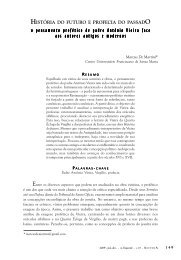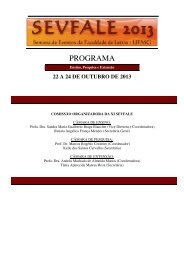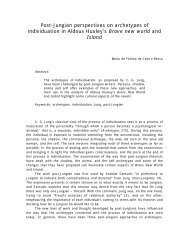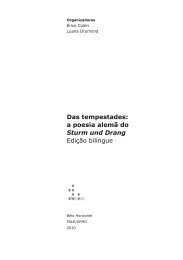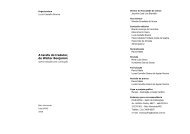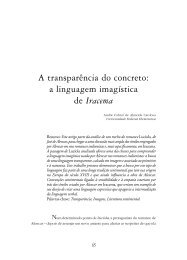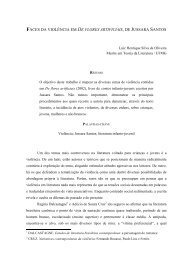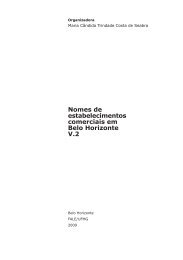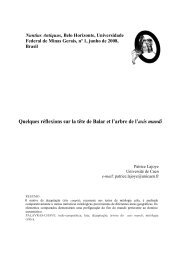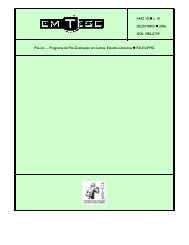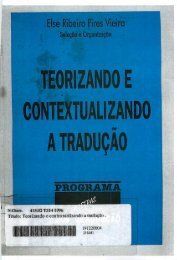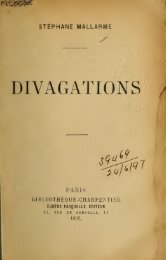E. E. Cummings: Modernist Painter and Poet
E. E. Cummings: Modernist Painter and Poet
E. E. Cummings: Modernist Painter and Poet
Create successful ePaper yourself
Turn your PDF publications into a flip-book with our unique Google optimized e-Paper software.
E. E. <strong>Cummings</strong>: <strong>Modernist</strong> <strong>Painter</strong> <strong>and</strong> <strong>Poet</strong><br />
Author(s): Milton A. Cohen<br />
Source: Smithsonian Studies in American Art, Vol. 4, No. 2 (Spring, 1990), pp. 54-74<br />
Published by: The University of Chicago Press on behalf of the Smithsonian American Art Museum<br />
Stable URL: http://www.jstor.org/stable/3108985 .<br />
Accessed: 05/04/2011 17:57<br />
Your use of the JSTOR archive indicates your acceptance of JSTOR's Terms <strong>and</strong> Conditions of Use, available at .<br />
http://www.jstor.org/page/info/about/policies/terms.jsp. JSTOR's Terms <strong>and</strong> Conditions of Use provides, in part, that unless<br />
you have obtained prior permission, you may not download an entire issue of a journal or multiple copies of articles, <strong>and</strong> you<br />
may use content in the JSTOR archive only for your personal, non-commercial use.<br />
Please contact the publisher regarding any further use of this work. Publisher contact information may be obtained at .<br />
http://www.jstor.org/action/showPublisher?publisherCode=ucpress. .<br />
Each copy of any part of a JSTOR transmission must contain the same copyright notice that appears on the screen or printed<br />
page of such transmission.<br />
JSTOR is a not-for-profit service that helps scholars, researchers, <strong>and</strong> students discover, use, <strong>and</strong> build upon a wide range of<br />
content in a trusted digital archive. We use information technology <strong>and</strong> tools to increase productivity <strong>and</strong> facilitate new forms<br />
of scholarship. For more information about JSTOR, please contact support@jstor.org.<br />
http://www.jstor.org<br />
The University of Chicago Press <strong>and</strong> Smithsonian American Art Museum are collaborating with JSTOR to<br />
digitize, preserve <strong>and</strong> extend access to Smithsonian Studies in American Art.
Milton A. Cohen<br />
Self-Portrait, 1958. Oil on canvas, 20 x 15<br />
in. National Portrait Gallery, Smithsonian<br />
Institution<br />
E. E. <strong>Cummings</strong><br />
Modenist <strong>Painter</strong> <strong>and</strong> <strong>Poet</strong><br />
As painters took down their can-<br />
vases after the huge 1919 exhibi-<br />
tion of the Society of Independent<br />
Artists in New York, one young art-<br />
ist eagerly wrote to his parents of<br />
his success:<br />
You may be glad to know that<br />
Gleizes(the 'first cubist"-probably<br />
the most individual,though somewhat<br />
cold, abstract painter in<br />
America,<strong>and</strong>-after Picasso-best<br />
known among painters of a<br />
type-was(to use Lachaise's phrase)<br />
"TAKEN OUT OF HIS FEET" by the<br />
two things of mine at the Independent.<br />
According to Nagle,he said<br />
later on that they were the "best<br />
things in oil" that he had seen<br />
"in America". Mr. [Walter] Pach,<br />
the director,was(as you may<br />
imagine)highly pleased;<strong>and</strong> said<br />
very pleasant things a propos<br />
when Nagle <strong>and</strong> I came to take<br />
away our things.1<br />
The painter who penned these ex-<br />
uberant words was the twenty-<br />
four-year-old E. E. <strong>Cummings</strong><br />
(1894-1962), <strong>and</strong> this was his first<br />
public exhibition.<br />
One of the paintings that im-<br />
pressed Albert Gleizes (1881-<br />
1953) was a large, square oil<br />
<strong>Cummings</strong> called Sound Number<br />
1 (fig. 1). A casual glance reveals<br />
an abstract formalism analogous to<br />
the "defamiliarized" surfaces<br />
<strong>Cummings</strong> was then devising in<br />
his poetry, a style that placed him<br />
in the orbit (though not in the ac-<br />
quaintance) of such contempo-<br />
raries as Morgan Russell (1886-<br />
1953), Abraham Walkowitz (1881-<br />
55 Smithsonian Studies in American Art<br />
1965), Max Weber (1881-1961),<br />
<strong>and</strong> Edward Bruce (1879-1943).2<br />
<strong>Cummings</strong>'s letter refers to three<br />
highly influential artists in postwar<br />
New York: the Cubist painter<br />
Albert Gleizes, the sculptor Gaston<br />
Lachaise (1882-1935), <strong>and</strong> the<br />
painter <strong>and</strong> director of the Society<br />
of Independent Artists, Walter<br />
Pach (1883-1958). Their recogni-<br />
tion-especially Gleizes's-of a<br />
young painter's first public effort<br />
is significant, <strong>and</strong> <strong>Cummings</strong><br />
seemed to be making important<br />
contacts in the New York art<br />
world only a few months after his<br />
discharge from the army in Jan-<br />
uary 1919. By this time, in fact,<br />
Lachaise was his close friend <strong>and</strong><br />
mentor, visiting <strong>Cummings</strong>'s<br />
studio often <strong>and</strong> offering him ad-<br />
vice <strong>and</strong> encouragement. Two<br />
weeks before <strong>Cummings</strong> wrote to<br />
his parents about the exhibition,<br />
Isabel Lachaise, the sculptor's wife,<br />
had asked him: "How does it feel<br />
to be the sensation of the Inde-<br />
pendent? That's what everyone is<br />
telling me."3<br />
Was <strong>Cummings</strong> the "sensation"<br />
of the 1919 Independent? Besides<br />
the opinions of Gleizes <strong>and</strong> Pach<br />
that <strong>Cummings</strong> recorded, more<br />
objective facts confirm that his<br />
work was noticed. First, of the<br />
more than six hundred canvases<br />
vying for the attention of the jour-<br />
nalists covering the exhibition,<br />
<strong>Cummings</strong>'s abstractions were<br />
among the few that received spe-<br />
cific mention: "The brilliant sally<br />
in color by Mr. <strong>Cummings</strong> will<br />
greatly impress those who have
1 Sound Number 1, 1919. Oil on canvas, 35<br />
x 35 in. The Metropolitan Museum of Art,<br />
Bequest of Scofield Thayer, 1982<br />
arrived at an appreciation of the<br />
abstract in art," wrote a reporter<br />
for the New York Sun. <strong>Cummings</strong><br />
also received invitations to exhibit<br />
elsewhere: at the Penguin Gallery,<br />
where he showed Sound Number<br />
2 (fig. 2) while the Independent<br />
was still on, <strong>and</strong>, as a result of his<br />
Independent entries, at an un-<br />
named gallery in Greenwich Vil-<br />
56 Spring 1990<br />
lage. He was even nominated<br />
(though not elected) as one of the<br />
twenty directors for the next Inde-<br />
pendent exhibition.4<br />
Whether these facts prove that<br />
<strong>Cummings</strong>'s premiere was a "sen-<br />
sation," they do suggest that by<br />
April 1919, on the basis of his<br />
public work, he was more likely<br />
to have been known (if at all) as a
2 Sound Number 2, 1919. Oil on paper, 19 x<br />
24 in. Memorial Art Gallenr of the<br />
University of Rochester, Gift of a friend of<br />
the gallery in memory of Hildegarde Lasell<br />
Watson<br />
57<br />
painter than a poet. Outside of his<br />
poems in the Harvard Monthly<br />
<strong>and</strong> a conventional piece or two<br />
in the Boston Evening Transcript,<br />
<strong>Cummings</strong>'s published poems by<br />
1919 numbered eight, appearing<br />
in a little-read, privately printed<br />
volume, Eight Harvard <strong>Poet</strong>s<br />
(1917). Several years were to pass<br />
before this public perception<br />
would change. For those today<br />
who know <strong>Cummings</strong> only as a<br />
poet, however, his painterly iden-<br />
tity in these years is intriguing.<br />
The <strong>Modernist</strong> <strong>Painter</strong><br />
Perhaps the two signal facts about<br />
<strong>Cummings</strong>'s background as a<br />
painter are that he was entirely<br />
self-taught <strong>and</strong> entirely serious<br />
about teaching himself. Although<br />
he painted <strong>and</strong> drew from child-<br />
hood, he began painting in ear-<br />
nest only during his last years at<br />
Harvard, 1915-16, when he be-<br />
came avidly interested in Mod-<br />
ernism in all the arts.5 Identifying<br />
himself with the avant-garde, how-<br />
ever, he equated academic instruc-<br />
tion with creative suicide. In art<br />
schools, <strong>Cummings</strong> wrote in 1920,<br />
Smithsonian Studies in American Art<br />
a pupil's originality is "irrevocably<br />
diluted" if not "entirely elimi-<br />
nated." He cited both Lachaise <strong>and</strong><br />
Paul Cezanne (1839-1906) as<br />
proof that "the man who by the<br />
gods has been fated to express<br />
himself will succeed in expressing<br />
himself in spite of all schools."6<br />
To nurture this independence<br />
<strong>and</strong> self-expression-qualities he<br />
cherished throughout his life-<br />
<strong>Cummings</strong> set about teaching him-<br />
self the fundamentals of his craft<br />
from a modernist perspective. A<br />
determined autodidact, he de-<br />
voured every available work on<br />
modern painting, even translating<br />
for himself A. J. Meier-Graefe's<br />
Cezanne und sein Kreis (1918).<br />
<strong>Cummings</strong> eagerly attended mod-<br />
ernist exhibitions beginning with<br />
the 1913 Armory Show in Boston,<br />
<strong>and</strong>, more important, he studied<br />
intensively on canvas, sketch pad,<br />
<strong>and</strong> notepaper the way basic ele-<br />
ments of painting interacted. His<br />
notes on painting in these years,<br />
preserved at the Houghton Library<br />
at Harvard University, are exten-<br />
sive <strong>and</strong> far exceed his notes on<br />
poetry.
Of the <strong>Modernist</strong>s whose tech-<br />
niques <strong>Cummings</strong> studied-<br />
Cezanne, Pablo Picasso (1881-<br />
1973), Gleizes, Henri Gaudier-<br />
Brzeska (1891-1915), <strong>and</strong> the Fu-<br />
turists-Cezanne was clearly the<br />
most influential. Quotations from<br />
Cezanne's letters <strong>and</strong> his aesthetic<br />
opinions, as recorded by Emile<br />
Bernard or interpreted by W. H.<br />
Wright <strong>and</strong> Meier-Graefe, turn up<br />
often in <strong>Cummings</strong>'s notes. But as<br />
with his study of the other mod-<br />
ernist masters, what <strong>Cummings</strong><br />
sought was not to imitate but to<br />
develop his own style. Thus he<br />
wrote to his mother in 1922, "In<br />
great part I've been using the<br />
world famous Cezanne palette ...<br />
but employing it not a Cezanne in<br />
his watercolors-feeling me out<br />
with it, rather; me times water<br />
times paper times dejaunir [?] so<br />
to speak."7 Shaping his mastery of<br />
modernist techniques <strong>and</strong> his own<br />
aesthetic principles into an orig-<br />
inal style was what mattered most<br />
to <strong>Cummings</strong> the painter, as it did<br />
to <strong>Cummings</strong> the poet.<br />
<strong>Poet</strong>ry was, of course, always a<br />
full partner in <strong>Cummings</strong>'s self-<br />
concept as an artist. When he<br />
moved into his first New York<br />
studio in January 1917, he was<br />
fully determined to pursue two ca-<br />
reers simultaneously-<strong>and</strong> with<br />
luck even support himself as well.<br />
He composed poems <strong>and</strong> even<br />
briefly held a conventional job<br />
with a mail-order bookseller<br />
during the day yet rallied his<br />
energies to paint "8-12" each<br />
night, as he informed his parents.<br />
His constant reports home about<br />
his painting suggest that, like so<br />
many artists of middle-class fami-<br />
lies, <strong>Cummings</strong> had to convince<br />
his parents (who were still paying<br />
the bills, after all) of his vocational<br />
intent <strong>and</strong> to free himself of their<br />
well-intentioned urging that he<br />
pursue the more rewarding career<br />
of writing prose. The letter he<br />
wrote to his mother on 2 March<br />
1922, excerpted below, reveals his<br />
exasperation.8<br />
But his parents were not the<br />
only ones <strong>Cummings</strong> had to con-<br />
vince: there was also himself. His<br />
roommate at the time, William<br />
Slater Brown, asked him (with the<br />
frankness permitted a roommate)<br />
why he should work so hard at<br />
painting when he was far more<br />
skillful at writing poetry. Cum-<br />
mings replied that because it was<br />
harder for him to paint, "it was<br />
artistically more important to<br />
achieve something in the more<br />
difficult medium."9 The argument<br />
seems contrived to convince him-<br />
self as much as his roommate.<br />
Similarly, <strong>Cummings</strong>'s frequent<br />
declarations of painterly intent to<br />
his parents might be seen as pro-<br />
testing too much, bolstering his<br />
own uncertainty.<br />
But despite parental pressure,<br />
the difficulty of the medium, the<br />
nagging question of identity, <strong>and</strong><br />
two major interruptions-nine<br />
months driving American ambu-<br />
lances <strong>and</strong> enduring internment in<br />
French prisons in 1917 <strong>and</strong> six<br />
months training in army boot<br />
camp from 1918 to 1919-<br />
Must I roar out that there are, live, eat, exist persons of<br />
sensitiveness<br />
stienesto whom the (as you infer)<br />
intelligence<br />
un-thorough-bred branches of my interest (e.g. poetry painting) ...<br />
appear as a more formidable achievement than prose? Or does the<br />
penchan[t] for running somebody else's mentality strike deeper than<br />
58 Spring 1990<br />
aught else within the Patemal heas ? Not sooth!<br />
mat heart'<br />
(Letter to Rebecca <strong>Cummings</strong>)
3 Noise Number 5, 1919-20. Oil on canvas,<br />
401/2 x 401/2 in. State University of New<br />
York College at Brockport Foundation<br />
4 Sound Number 5, 1920. Oil on canvas, 42<br />
x 36 in. State University of New York<br />
College at Brockport Foundation<br />
5 Morgan Russell, Synchromy in Orange: To<br />
Form, 1913-14. Oil on canvas, 135 x<br />
1211/2 in. Albrigbt-Knox Art Gallery,<br />
Buffalo, New York, Gift of Seymour H.<br />
Knox, 1958<br />
<strong>Cummings</strong> kept painting. By 1920,<br />
he had worked on ten abstractions<br />
in the series begun the year be-<br />
fore, for his entries in the 1920 In-<br />
dependent exhibition were enti-<br />
tled Noise Number 5 <strong>and</strong> Sound<br />
Number 5 (figs. 3, 4).<br />
Not surprisingly, these early ab-<br />
stractions bear the imprint of sev-<br />
eral <strong>Modernist</strong>s whom <strong>Cummings</strong><br />
admired. Sound Number 5 recalls<br />
the synchromist abstractions of<br />
Morgan Russell such as Synchromy<br />
in Orange: To Form (fig. 5).<br />
<strong>Cummings</strong> learned of Synchro-<br />
mism through Willard Huntington<br />
Wright's Modem Painting: Its<br />
Tendency <strong>and</strong> Meaning (1915).<br />
The brother of the synchromist<br />
painter Stanton MacDonald-Wright<br />
(1890-1973), W. H. Wright publi-<br />
cized the movement, explained its<br />
aesthetics, <strong>and</strong> displayed its paint-<br />
ings at the important Forum exhi-<br />
bition of 1916, which <strong>Cummings</strong><br />
probably attended. From Wright's<br />
discussions <strong>and</strong> Russell's applica-<br />
tions, <strong>Cummings</strong> derived his in-<br />
terest in juxtaposing color planes<br />
to achieve the "bumps <strong>and</strong> hol-<br />
lows" of three-dimensional form.<br />
59 Smithsonian Studies in American Art<br />
Russell may also have inspired<br />
<strong>Cummings</strong>'s penchant for bio-<br />
morphic abstraction in sub-<br />
merging figurative motifs just<br />
below the surface of an abstract<br />
design. Both Sound Number 5 <strong>and</strong><br />
Synchromy in Orange abstract a<br />
torso in contrapposto into large<br />
color planes. Sometimes, in fact,<br />
<strong>Cummings</strong>'s figures break through<br />
the abstract surface, as the ele-<br />
phant does in Noise Number 1<br />
(fig. 6), his other entry to the 1919<br />
Independent. Essentially, however,<br />
he thought of his motifs as "or-<br />
ganizations of colour <strong>and</strong> line."10<br />
Picasso's Cubism, the Futurists,<br />
<strong>and</strong> their American exponents also<br />
informed <strong>Cummings</strong>'s early aes-<br />
thetics. He admired Picasso's<br />
"elimination of [the] trivial, pretty,<br />
[<strong>and</strong>] charming" in directly con-<br />
veying "sensations of weight, so-<br />
lidity, Depth (hugeness)," <strong>and</strong> he<br />
even devoted an entire poem to<br />
Picasso, concluding, "You hew<br />
form truly." But <strong>Cummings</strong> dis-<br />
liked Cubism's ponderousness <strong>and</strong><br />
stasis: Cubism created a "cold <strong>and</strong><br />
frozen grammar" <strong>and</strong> adminis-<br />
tered "an overdose of architecture
6 Noise Number 1, 1919. Oil on canvas, 36<br />
x 36 in. State University of New York<br />
College at Brockport Foundation<br />
7 Joseph Stella, Battle of Lights: Coney Isl<strong>and</strong>,<br />
1913. Oil on canzas, 76 x 84 in. Yale<br />
University Art Gallery, New Haven,<br />
Connecticut, Gift of Collection Societe<br />
Anonyme<br />
to the human form," he com-<br />
plained in 1918.11 Futurist dyna-<br />
mism nicely compensated Cubist<br />
stasis, but <strong>Cummings</strong> distrusted<br />
the Futurists' posturing bravado:<br />
early <strong>and</strong> late, he respected indi-<br />
viduals, not groups. Among Fu-<br />
turist-inspired American painters,<br />
he especially admired Joseph<br />
Stella (1880-1946) <strong>and</strong> John Marin<br />
(1870-1953). <strong>Cummings</strong> met<br />
Stella in 1919, <strong>and</strong> Stella's Battle<br />
of Lights: Coney Isl<strong>and</strong> (fig. 7)<br />
probably inspired the tangle of<br />
serpentine <strong>and</strong> jagged lines <strong>and</strong><br />
elliptical curves that <strong>Cummings</strong><br />
created a few months later in<br />
Noise Number 5. Like Stella,<br />
<strong>Cummings</strong> went to Coney Isl<strong>and</strong><br />
to "capture colour <strong>and</strong> motion."<br />
And like Marin, he found New<br />
York skyscrapers, such as the<br />
Woolworth Building (fig. 8), alive<br />
<strong>and</strong> dynamic-apt subjects for<br />
paintings such as New York, 1927<br />
(fig. 9) <strong>and</strong> its poetic counterpart<br />
"at the ferocious phenomenon of<br />
5 o'clock i find myself."12 For all<br />
their indebtedness, however,<br />
<strong>Cummings</strong>'s early abstractions re-<br />
tain their individuality in the way<br />
60 Spring 1990<br />
they transform these influences<br />
into a unique whole. Their poised<br />
tensions of planar solidity <strong>and</strong> dy-<br />
namism, of an abstract design <strong>and</strong><br />
its figurative origins, embody aes-<br />
thetic ideas <strong>Cummings</strong> had devel-<br />
oped in his notes <strong>and</strong> applied to<br />
his poetry as well.<br />
The public response to<br />
<strong>Cummings</strong>'s entries at the 1920 In-<br />
dependent exhibition must have<br />
exceeded his most optimistic ex-<br />
pectations. This time reviewers<br />
from four newspapers mentioned<br />
his paintings. One called them<br />
"a striking bit of post-impres-<br />
sionism." Another recommended<br />
that <strong>Cummings</strong>'s paintings be in-<br />
cluded in future exhibitions of ab-<br />
stract art. The most detailed re-<br />
view appeared in the Evening Post:<br />
E. E. <strong>Cummings</strong> entitles one of<br />
these [abstractions] "Noise Number<br />
5" <strong>and</strong> the other "Sound Number<br />
5". Of the two, we preferred the<br />
noise; both of them are interesting.<br />
Of course, these irregular patterns<br />
of sharp positive color are banners<br />
of a small army of theorists, <strong>and</strong><br />
the theories will either entrance
8 John Marin, Lower Manhattan (Composing<br />
derived from top of Woolworth), 1922.<br />
Watercolor <strong>and</strong> charcoal with paper<br />
cutout attached with thread on paper,<br />
215/8 x 267/8 in. The Museum of Modern<br />
Art, Lillie P. Bliss Bequest<br />
9 New York, 1927, 1926-27. Oil on canvas,<br />
67 x 42 in. Published in E. E. <strong>Cummings</strong>,<br />
CIOPW (New York: Covici-Friede, 1931)<br />
you or set your teeth on edge, ac-<br />
cording to the bias of your theo-<br />
ries. But if the paintings can be<br />
looked at with the eye, if they can<br />
be seen as frankly as one sees the<br />
pattern of a roll of linoleum they<br />
are bound to be admired.13<br />
In the spring of 1920,<br />
<strong>Cummings</strong> was busily developing<br />
another outlet for his art <strong>and</strong><br />
writing: Dial magazine, which had<br />
been recently taken over by his<br />
two close friends, Scofield Thayer<br />
(1890-1982) <strong>and</strong> Sibley Watson<br />
(1894-1982). Under their superb<br />
guidance, it would become the<br />
best <strong>and</strong> most influential little<br />
magazine of the 1920s, <strong>and</strong><br />
<strong>Cummings</strong>'s work-poems, essays,<br />
paintings, <strong>and</strong> twenty-two line<br />
drawings-graced mary of its is-<br />
sues over the next nine years.<br />
Here his poetic innovations often<br />
appeared alongside his line draw-<br />
ings. The best of these drawings,<br />
such as Charles Spencer Chaplin,<br />
reveal <strong>Cummings</strong>'s talent for com-<br />
pressing character <strong>and</strong> motion<br />
into a few sinuous strokes (fig.<br />
10). His fluent line fuses several<br />
61 Smithsonian Studies in American Art<br />
features of the comedian: his for-<br />
lorn shuffle, legs <strong>and</strong> feet seeming<br />
to fold into each other; his tragi-<br />
comic nature in the rose <strong>and</strong> cane;<br />
the ingratiating, waifish smile in<br />
the subserviently bent head; <strong>and</strong><br />
his nimble dexterity both in bal-<br />
ancing the rose <strong>and</strong> in seeming to<br />
come toward the viewer with his<br />
top half while moving away with<br />
his bottom half.<br />
Given the modernist audience<br />
for these Dial drawings (not to<br />
mention the distinguished com-<br />
pany they kept with works of<br />
Picasso, Andre Derain [1880-<br />
1954], Henri Matisse [1869-1954],<br />
<strong>and</strong> others), <strong>and</strong> given that<br />
<strong>Cummings</strong>'s large abstractions<br />
caught the eye-<strong>and</strong> usually the<br />
approval-of journalists covering<br />
every Independent exhibition he<br />
entered from 1919 to 1924,<br />
<strong>Cummings</strong> seemed well on his<br />
way to establishing himself pub-<br />
licly, like Dante Gabriel Rossetti<br />
(1828-1882) before him, as an<br />
artist of two equal callings, a Mod-<br />
ernist of poetry <strong>and</strong> painting. In-<br />
deed, in one of the first serious<br />
studies of <strong>Cummings</strong>'s poetry in
10 Charles Spencer Chaplin, 1924. Ink<br />
drawing published in the Dial 76 (March<br />
1924): 248<br />
11 A Line Drawing, 1922. Ink drawing<br />
published in the Dial 72 (January 1922):<br />
46<br />
1923, the critic Gorham Munson<br />
concluded that "a complete study<br />
of <strong>Cummings</strong> should take pene-<br />
trating account of his painting <strong>and</strong><br />
drawing, <strong>and</strong> no estimate of his<br />
literary work can begin without<br />
noting the important fact that<br />
<strong>Cummings</strong> is a painter."14<br />
Just how thoroughly <strong>Cummings</strong><br />
himself believed this "fact," how-<br />
ever, is open to question. Despite<br />
his steady output of large abstrac-<br />
tions (at least fifteen by 1921), his<br />
early successes, <strong>and</strong> his declara-<br />
tions to his parents, peculiar<br />
lapses in his emerging career as a<br />
painter hint at professional uncer-<br />
tainty. For one thing, <strong>Cummings</strong><br />
was not aggressive in seeking ex-<br />
hibitions <strong>and</strong> one-artist shows in<br />
the 1920s, settling instead for a<br />
place in the yearly Independent<br />
exhibition. The Dial, of course,<br />
carried his line drawings to an in-<br />
fluential readership, but reproduc-<br />
tions in a magazine are no substi-<br />
tute for paintings in a gallery.<br />
Moreover, the mediocre quality of<br />
several drawings published in the<br />
Dial (e.g., fig. 11) suggests that<br />
Thayer <strong>and</strong> Watson may have<br />
placed personal friendship over<br />
their much-vaunted taste. Such<br />
preferential treatment could have<br />
stunted <strong>Cummings</strong>'s ability to criti-<br />
cize his own work, judgment he<br />
badly needed if no art teacher was<br />
to look over his shoulder. Equally<br />
important, after 1919 <strong>Cummings</strong><br />
did not generally associate with<br />
painters. Certainly he knew of the<br />
circle of Alfred Stieglitz (1864-<br />
1946) <strong>and</strong> probably visited<br />
Stieglitz's gallery "291," but he<br />
made no contacts with this impre-<br />
sario who might have arranged a<br />
one-artist show for him as he had<br />
done for so many other young<br />
<strong>Modernist</strong>s. Apart from Lachaise<br />
<strong>and</strong> his stepson, the painter<br />
Edward Nagle (1893-?),<br />
<strong>Cummings</strong>'s friends were nearly<br />
all writers or Harvard chums, <strong>and</strong><br />
he was aloof to gallery politics, a<br />
62 Spring 1990<br />
loner. His distrust of coteries may<br />
have prevented his making important<br />
contacts with other painters<br />
<strong>and</strong> patrons, but his distrust of<br />
himself probably explains his reluctance<br />
to seek out one-artist<br />
shows. He may not have felt<br />
ready yet.<br />
Such reluctance may also partly<br />
explain <strong>Cummings</strong>'s decision to<br />
leave America in 1921 <strong>and</strong> settle<br />
in Paris for the next three years.<br />
To judge from the hundreds of<br />
drawings he made abroad, he apparently<br />
felt the need to rethink<br />
his aesthetics <strong>and</strong> rework his techniques.15<br />
In Paris he had easy access<br />
to his favorite artists, <strong>and</strong> the<br />
sketch pad was a convenient place<br />
to work out compositional ideas<br />
gleaned from the Bernheim-Jeune<br />
Gallery <strong>and</strong> the Luxembourg Museum.<br />
But in America, <strong>Cummings</strong>'s<br />
painting virtually disappeared. The<br />
Sounds <strong>and</strong> Noises yielded to silence,<br />
<strong>and</strong> only a few of his watercolors<br />
were exhibited.<br />
At the same time, however,<br />
<strong>Cummings</strong>'s literary reputation<br />
blossomed with the publication of<br />
The Enormous Room in 1922, Tulips<br />
<strong>and</strong> Chimneys in 1923, <strong>and</strong><br />
poems in numerous little magazines.<br />
And unlike his abstract<br />
painting, which belonged to a<br />
broader modernist movement, his<br />
poems had indeed "done something<br />
FIRST," as he boasted to his<br />
father. His typographical innovations<br />
sparked an immediate <strong>and</strong><br />
lasting controversy, <strong>and</strong> <strong>Cummings</strong><br />
was soon known for them. Thus<br />
we find the potent irony that<br />
when he returned to America in<br />
December 1923, <strong>Cummings</strong> still<br />
considered himself "primarily a<br />
painter," as he wrote to his father,<br />
yet to a journalist reviewing his<br />
painting at the 1924 Independent<br />
exhibition, he was already "better<br />
known as a poet <strong>and</strong> novelist."16<br />
What heightens this irony is<br />
that <strong>Cummings</strong>'s painting had matured<br />
during his Parisian hiatus.
12 Noise Number 12, 1924. Oil on canvas, 50<br />
x 40 in. Iconography Collection, Harry<br />
Ransom Humanities Research Center,<br />
University of Texas at Austin<br />
13 Noise Number 13, 1925. Oil on canvas,<br />
5912 x 43 in. Private collection, New York<br />
His Noise Number 12 of 1924 <strong>and</strong><br />
Noise Number 13 of the following<br />
year are markedly superior to the<br />
earlier abstractions in their fluency<br />
of line, concentrated force, <strong>and</strong><br />
balance of planar weight <strong>and</strong> dy-<br />
namism (figs. 12, 13). The noise of<br />
Noise Number 12, for example, is<br />
clearly jazz, conveyed not only by<br />
the central figure suggesting a sax-<br />
ophone <strong>and</strong> the silhouetted hints<br />
of toe tapping <strong>and</strong> faces <strong>and</strong> h<strong>and</strong>s<br />
making music, but also by the<br />
flowing, twisting, <strong>and</strong> jaggedly syn-<br />
copated rhythm lines.17 The aural<br />
metaphor of these visual images<br />
63 Smithsonian Studies in American Art<br />
impressed a reporter from the<br />
New York Sun <strong>and</strong> Globe as being<br />
especially apt: he gave Noise<br />
Number 12 premier mention in<br />
reviewing the 1924 Independent.18<br />
If Noise Number 12 portrays<br />
fluent rhythms, Noise Number 13<br />
emphasizes conflicting tensions of<br />
expansion <strong>and</strong> contraction. Tubes<br />
<strong>and</strong> cones push in toward the<br />
center, spirals spin out toward the<br />
edges <strong>and</strong> coil inward to suggest<br />
three-dimensional depth, <strong>and</strong> the<br />
foreshortened cylinder at bottom<br />
center leads down into the design<br />
to convey height. These conflicts
14 sea, 1944. Oil on canvasboard, 12 x 16 in.<br />
State University of New York College at<br />
Brockport Foundation<br />
15 View from Joy Farm: Mt. Chocorua, 1941.<br />
Oil on canvas, 38 x 48 in. Private<br />
collection<br />
of directional force <strong>and</strong> dimension<br />
create (to quote from <strong>Cummings</strong>'s<br />
play Him) "a kinesis fatally com-<br />
posed of countless mutually de-<br />
pendent stresses, a product-<strong>and</strong>-<br />
quotient of innumerable perfectly<br />
interrelated tensions." <strong>Cummings</strong><br />
liked this oil well enough to have<br />
it reproduced several times: in the<br />
1925 Independent catalogue, in<br />
the Dial of August 1927, <strong>and</strong> in his<br />
1931 art book, entitled CIOPW<br />
64 Spring 1990<br />
(charcoal, ink, oil, pencil, water-<br />
color). But it proved to be his fare-<br />
well to modernist abstraction: late<br />
in 1926 he revealed, in a letter to<br />
his mother, that he hoped "to re-<br />
sume Painting but in a new<br />
direction."19<br />
The "new direction" developed<br />
in New York, 1927, an ambitious<br />
oil that superimposes a larger-<br />
than-life nude over a Marinesque<br />
melange of tulips, chimneys, <strong>and</strong>
16 Untitled (Man Worshiping Moon), n.d. Oil<br />
on cardboard, 15 x 8 in. State University of<br />
New York College at Brockport Foundation<br />
skyscrapers (see fig. 9). Clearly<br />
<strong>Cummings</strong> was seeking a style that<br />
would reconcile the figurative <strong>and</strong><br />
abstract without sacrificing either.<br />
In this retreat from modernist ab-<br />
straction, he was certainly not<br />
alone. Indeed, by 1926 scarcely<br />
any American painter besides<br />
Arthur Dove (1880-1946) <strong>and</strong><br />
Stuart Davis (1894-1964) main-<br />
tained the abstract styles of the<br />
teens. As the critic Sam Hunter<br />
observed, "The rapid decline of<br />
American experimental art [in the<br />
early 1920s] left a vacuum which<br />
increasingly all but the most reso-<br />
lute innovators filled by relaxing<br />
into less dem<strong>and</strong>ing styles of re-<br />
alism or eclecticism."20 But just as<br />
with his development of a mod-<br />
ernist style, external fashion mat-<br />
tered far less to <strong>Cummings</strong> than<br />
did a personal aesthetics, which<br />
abstraction could no longer fulfill.<br />
His "new direction," moreover,<br />
did not evolve into a single style,<br />
for he painted in several styles in<br />
subsequent years, from the<br />
expressionism of sea (fig. 14), to<br />
the naturalism of View from Joy<br />
Farm: Mt. Chocorua (fig. 15), to<br />
the dreamy sort of night painting<br />
of Untitled (fig. 16).<br />
By "new direction," <strong>Cummings</strong><br />
meant less a new style than a new<br />
orientation to the subject, one that<br />
ab<strong>and</strong>oned the detached objec-<br />
tivity of Modernism for an<br />
engaged subjectivity <strong>and</strong> that<br />
embraced nature as a medium of<br />
self-expression rather than as an<br />
accessory to an abstract design. As<br />
in New York, 1927, he sought to<br />
transcend categorical distinctions<br />
between abstract <strong>and</strong> figural, nat-<br />
ural <strong>and</strong> human: his trees twist an-<br />
thropomorphically; his clouds<br />
swirl apocalyptically. In his Self-<br />
Portrait with Sketchpad, for ex-<br />
ample, the tree trunk-a curving<br />
feminine torso-extends a shel-<br />
tering branch over the artist (fig.<br />
17). Is she the artist's muse or the<br />
Jungian complement, the anima, to<br />
65 Smithsonian Studies in American Art<br />
his animus, his identity as an<br />
artist? For a poet <strong>and</strong> painter who<br />
revered nature as deeply as<br />
<strong>Cummings</strong> did-<strong>and</strong> who specu-<br />
lated in Jungian terms on the fem-<br />
inine side of his creativity-this<br />
need to express the relation be-<br />
tween self <strong>and</strong> nature, male <strong>and</strong><br />
female, was as essential to his ar-<br />
tistic identity as his need to recon-<br />
cile the figural <strong>and</strong> abstract was to<br />
his aesthetics.21<br />
<strong>Cummings</strong> felt that his new di-<br />
rection suited his identity as an<br />
artist. In encouraging spontaneity<br />
<strong>and</strong> self-expression, it permitted<br />
his painting "to live suddenly<br />
without thinking," as he put it in<br />
one early poem.22 Expressive<br />
freedom, in turn, encouraged sty-<br />
listic uniqueness, an all-important<br />
quality for this artist. For several<br />
reasons, however, <strong>Cummings</strong>'s<br />
ab<strong>and</strong>onment of modernist ab-<br />
straction proved to be a critical<br />
disaster. While he tinkered with<br />
his new direction, he became<br />
even more reticent to display his<br />
work outside the yearly Indepen-<br />
dent exhibition. Not until 1931 did<br />
he "go public" with two one-artist<br />
shows <strong>and</strong> with his art book<br />
CIOPW. By this time, however, he<br />
had published five volumes of po-<br />
etry, participated in a sixth, <strong>and</strong><br />
written a book-length narrative, a<br />
play (produced in 1927), <strong>and</strong><br />
about two dozen short essays for<br />
the Dial <strong>and</strong> Vanity Fair.<br />
If <strong>Cummings</strong> was "better<br />
known as a poet <strong>and</strong> novelist" in<br />
1924, he was likely known only as<br />
a writer by 1931. Critics who re-<br />
viewed his one-artist shows in the<br />
years thereafter-notably in 1934,<br />
1944, <strong>and</strong> 1949-invariably ex-<br />
pressed surprise on learning that<br />
the bad boy of American letters<br />
also painted; they thus viewed the<br />
paintings as "A Parenthesis to the<br />
Career of a <strong>Poet</strong>," as Hilton<br />
Kramer entitled a 1968 review.<br />
The critics were also surprised-<br />
unpleasantly, for the most part-
17 Self-Portrait with Sketchpad, 1939. Oil on<br />
canvas, 43 x 311/2 in. Iconography<br />
Collection, Harry Ransom Humanities<br />
Research Center, University of Texas at<br />
Austin<br />
that <strong>Cummings</strong>'s postmodernist<br />
painting did not pose the visual<br />
challenge of his writing. Henry<br />
McBride's response to <strong>Cummings</strong>'s<br />
1934 exhibition is typical: "You<br />
could never imagine [the paint-<br />
ings] to be by the author of 'Eimi.'<br />
They are thin, uncertain, <strong>and</strong> sepa-<br />
rated by some curious wall of in-<br />
hibition from the medium."23<br />
<strong>Cummings</strong>'s stylistic mean-<br />
dering in his later work strength-<br />
ened the critics' misconception<br />
66 Spring 1990<br />
that painting was only a pastime<br />
for him. In turn, their coolness to<br />
his later work <strong>and</strong> misreading of<br />
his seriousness probably kept him<br />
from exhibiting more often (he<br />
had ten one-artist shows after<br />
1927) <strong>and</strong> impelled him after 1949<br />
to seek safer havens, like Roch-<br />
ester, New York, when he did ex-<br />
hibit: thus the vicious circle of pri-<br />
vacy causing misconception <strong>and</strong><br />
misconception causing greater<br />
privacy.
Whether <strong>Cummings</strong> could have<br />
succeeded in establishing a public<br />
persona as a painter had he con-<br />
tinued his modernist style is a<br />
moot but interesting question. All<br />
the abstractions he exhibited pub-<br />
licly proved their power to cap-<br />
ture the eye, just as his early po-<br />
etry did. His last abstractions,<br />
Noise Number 12 <strong>and</strong> Noise<br />
Number 13, moreover, demon-<br />
strate an impressive growth in sty-<br />
listic confidence <strong>and</strong> suggest that,<br />
had he continued in this vein, he<br />
might have developed a distinctly<br />
personal <strong>and</strong> recognizable br<strong>and</strong><br />
of Modernism, as Stuart Davis did,<br />
for example, even as modernist<br />
abstraction faded from the Amer-<br />
ican scene. But <strong>Cummings</strong>'s failure<br />
to develop his painterly potential<br />
in the early 1920s to match his<br />
burgeoning reputation as a writer<br />
<strong>and</strong> his ab<strong>and</strong>onment of Mod-<br />
ernism later in the decade effec-<br />
tively consigned his later painting<br />
to obscurity.<br />
Painting <strong>and</strong> Poem: Some<br />
Comparative Approaches<br />
In a catalogue statement for one<br />
of his one-artist shows, <strong>Cummings</strong><br />
posed <strong>and</strong> answered a persistent<br />
question about how his two arts<br />
cohered in practice:<br />
Tell me, doesn't your painting in-<br />
terfere with your writing?<br />
Quite the contrary: they love each<br />
other dearly.24<br />
Indeed, that "mutual love" marked<br />
the modernist movement as a<br />
whole. Interminglings of the arts<br />
were visible everywhere: in<br />
Richard Wagner's (1813-1883)<br />
Gesamtkunstwerk; in the Symbol-<br />
ists' colloquies <strong>and</strong> shared sub-<br />
jects; in Ezra Pound's (1885-1972)<br />
forays into other arts to exp<strong>and</strong><br />
his concept of the image; in<br />
Gertrude Stein's (1874-1946)<br />
Cubist-inspired portraits; in Arnold<br />
Schonberg's (1874-1951) painting<br />
67 Smithsonian Studies in American Art<br />
<strong>and</strong> composing with the Munich<br />
expressionist group Blaue Reiter;<br />
<strong>and</strong> in the influence that Marcel<br />
Duchamp (1887-1968), Charles<br />
Sheeler (1883-1965), <strong>and</strong> Charles<br />
Demuth (1883-1939) exerted on<br />
William Carlos Williams's (1883-<br />
1963) poetry, to cite but a few in-<br />
stances. But perhaps for no one<br />
more than <strong>Cummings</strong> were two<br />
arts so closely connected <strong>and</strong> mu-<br />
tually interactive, since he not only<br />
devoted equal time to each but<br />
also guided them both by a<br />
common set of aesthetic<br />
principles.<br />
Early on, critics recognized the<br />
importance of considering to-<br />
gether <strong>Cummings</strong>'s "twin obses-<br />
sions," as he called them, but this<br />
awareness soon faded with his<br />
public persona as a painter <strong>and</strong><br />
did not reemerge until the late<br />
1970s. Comparative studies since<br />
then have noted parallels in sub-<br />
ject matter, genre, technique, <strong>and</strong>,<br />
more recently, aesthetics.25 All<br />
these approaches deserve mention<br />
to emphasize how profoundly<br />
<strong>Cummings</strong>'s visual imagination in-<br />
formed his poetry-but not equal<br />
mention, since they do not equally<br />
delineate the relations between<br />
his arts. Similarly, any comparative<br />
method must be sensitive to dif-<br />
ferences in <strong>Cummings</strong>'s practice<br />
<strong>and</strong> skill in the two arts <strong>and</strong> to<br />
their apparent stylistic divergences.<br />
Given <strong>Cummings</strong>'s strong re-<br />
sponse to the subject <strong>and</strong> his un-<br />
abashed romanticism, it is hardly<br />
surprising that the things he cared<br />
about-mountains <strong>and</strong> flowers,<br />
friends <strong>and</strong> lovers-should inhabit<br />
his poems <strong>and</strong> later canvases<br />
equally. Even the most casual<br />
reader of his poems, for example,<br />
quickly discerns how profoundly<br />
<strong>Cummings</strong> loved nature, a love<br />
that, in fusing childlike joy <strong>and</strong> re-<br />
ligious reverence, could reach a<br />
pitch of lyrical ecstasy, or just as<br />
easily fall into saccharine<br />
sentimentality:
when faces called flowers float out of the ground<br />
-it's april(yes,april;my darling)it's spring!<br />
yes the pretty birds frolic as spry as can fly<br />
yes the little fish gambol as glad as can be<br />
(yes the mountains are dancing together)26<br />
The same two-edged potential<br />
holds for the views of Mount Cho-<br />
corua that <strong>Cummings</strong> painted tire-<br />
lessly from his family's farm in the<br />
White Mountains of New Hamp-<br />
shire, much as his hero, Paul<br />
Cezanne, repeatedly returned to<br />
the distant motif of Mont Sainte-<br />
Victoire. Indeed, <strong>Cummings</strong>'s View<br />
from Joy Farm (see fig. 15) even<br />
borrows the framing motif from<br />
Cezanne's Mont Sainte-Victoire<br />
(1886-88, Courtauld Institute). As<br />
View from Joy Farm suggests,<br />
these l<strong>and</strong>scapes, while technically<br />
accomplished, sometimes lapse<br />
into prettiness <strong>and</strong> conventionality.<br />
Occasionally, though, when inspi-<br />
ration overcame his chronic un-<br />
certainty in oils, <strong>Cummings</strong> could<br />
turn out impressive work, particu-<br />
larly in watercolors calling for<br />
light, fast brushwork. His painting<br />
Untitled (fig. 18), in capturing one<br />
moment of a shifting, tumultuous<br />
68 Spring 1990<br />
n(o)w<br />
how<br />
the<br />
dis(appeared cleverly)world<br />
iS Slapped:with;liGhtninG<br />
sky, recalls the nature poems that,<br />
although carefully crafted, evoke a<br />
startling moment-a lightning<br />
bolt, for example, as in the poem<br />
"n(o)w," excerpted below-with<br />
the feeling of spontaneity.2'<br />
Comparisons of subject matter<br />
in the paintings <strong>and</strong> poems may<br />
reveal shared themes <strong>and</strong> likewise<br />
suggest parallel strengths (inspired<br />
spontaneity) <strong>and</strong> weaknesses (sen-<br />
timentality, triteness) to which<br />
<strong>Cummings</strong>'s work in each medium<br />
is prone. But such comparisons do<br />
not really explain how his painting<br />
relates to his poetry.<br />
Genre brings us a little closer.<br />
The other side of <strong>Cummings</strong>'s lyr-<br />
ical affirmation was his corrosive<br />
satire <strong>and</strong> biting portraiture. As his<br />
Chaplin (see fig. 10) shows, Cum-<br />
mings had a caricaturist's eye for<br />
telling detail. Even in a drawing<br />
obviously tossed off in a hurry,<br />
such as one of his friend <strong>and</strong> pa-<br />
at<br />
which(shal)lpounceupcrackw(ill)jumps<br />
of<br />
THuNdeRB<br />
loSSo!M<br />
(Excerpt from E. E. <strong>Cummings</strong>, "n(o)w")
18 Untitled (L<strong>and</strong>scape with Stormy Sky), n.d.<br />
Watercolor on paper, 812 x 11 in. Prizate<br />
collection<br />
tron Scofield Thayer, <strong>Cummings</strong><br />
wittily captures Thayer's aristo-<br />
cratically arched brow <strong>and</strong> dan-<br />
dified bow mouth (fig. 19). In<br />
<strong>Cummings</strong>'s poetry, satire figures<br />
even more prominently. It pro-<br />
vided the perfect medium to at-<br />
tack values he opposed, for the<br />
Reverend Edward <strong>Cummings</strong>'s son<br />
was, beneath his celebrations of<br />
the senses, a moralist, albeit a<br />
witty one. As both his contempo-<br />
raries <strong>and</strong> his recorded Nonlec-<br />
tures confirm, he had a superb ear<br />
<strong>and</strong> voice for mimicry.28 Witness<br />
his evocation of the half-formed<br />
thoughts, half-swallowed syllables,<br />
<strong>and</strong> half-human savagery of this<br />
South Boston "tough" opining on<br />
what wartime America should do<br />
to the Japanese:<br />
69 Smithsonian Studies in American Art<br />
ygUDuh<br />
ydoan<br />
yunnuhstan<br />
ydoan o<br />
yunnuhstan dem<br />
yguduh ged<br />
yunnuhstan dem doidee<br />
yguduh ged riduh<br />
ydoan o nudn<br />
LISN bud LISN<br />
dem<br />
gud<br />
am<br />
duhSIVILEYEzum29<br />
lidl yelluh bas<br />
tuds weer goin
19 Untitled (Scofield Thayer), before 1923.<br />
Pencil drawing, 81/2 x 11 in. E. E.<br />
<strong>Cummings</strong> Papers, Houghton Library,<br />
Hanrard University<br />
Both expressions of satire demonstrate<br />
<strong>Cummings</strong>'s sensitivity to<br />
visual <strong>and</strong> aural nuance <strong>and</strong> his<br />
ability to exaggerate nuance into<br />
caricature <strong>and</strong> mimicry. Yet poetry<br />
gave him more opportunity for<br />
subtlety, for thematic complexity<br />
<strong>and</strong> double entendre, such as slipping<br />
"EYE" into "SIVILEYEz" to<br />
recall one moral code that the<br />
speaker would no doubt affirm:<br />
"an eye for an eye." With brush<br />
<strong>and</strong> pen, <strong>Cummings</strong> was no<br />
George Grosz (1893-1959) <strong>and</strong><br />
could not achieve a comparable<br />
subtlety.<br />
When we turn to the visual devices<br />
in <strong>Cummings</strong>'s poetry <strong>and</strong><br />
compare them to analogous devices<br />
in his paintings <strong>and</strong> to the<br />
aesthetic principles generating<br />
both, the connections between the<br />
two arts become tighter. Although<br />
<strong>Cummings</strong>'s famous typographical<br />
innovations in one sense came out<br />
of the free verse movement of the<br />
teens <strong>and</strong> owe much to Pound<br />
<strong>and</strong> perhaps to Guillaume<br />
Apollinaire (1880-1918), they owe<br />
even more to his own painterly vi-<br />
sion-only now the typewriter<br />
served as his paintbrush. In this<br />
regard, critics have often <strong>and</strong><br />
rightly observed how much the<br />
typewriter, with its sharply delineated<br />
print, its precision of placement,<br />
<strong>and</strong> its mechanical regu-<br />
70 Spring 1990<br />
larity, enhanced <strong>and</strong> even<br />
stimulated <strong>Cummings</strong>'s visual dis-<br />
locations. One element in both<br />
media can serve as an example.<br />
As a painter, <strong>Cummings</strong> knew<br />
how directly line creates or<br />
impedes motion. As he acknowl-<br />
edged in his foreword to is 5, his<br />
1926 book of poems, "I am abnor-<br />
mally fond of that precision which<br />
creates movement." His unpub-<br />
lished notes, moreover, speculate<br />
often <strong>and</strong> in detail on methods to<br />
achieve motion in both arts <strong>and</strong><br />
the types of motion various lines<br />
effect.30 Not surprisingly, then,<br />
such abstractions as Noise Number<br />
1 (see fig. 6) emphasize lines that<br />
create dynamism-sweeping arcs<br />
<strong>and</strong> curves, diagonals-while es-<br />
chewing more static horizontals<br />
<strong>and</strong> verticals.<br />
In <strong>Cummings</strong>'s poems, line is<br />
more complex, for it functions in<br />
dimensions of space <strong>and</strong> time si-<br />
multaneously.31 As the poem un-<br />
folds temporally, the narrative line<br />
conveys motion through its pace,<br />
its accelerations <strong>and</strong> retards. Si-<br />
multaneously, however, the short<br />
lyric (<strong>Cummings</strong>'s metier) exists<br />
in space, its line lengths <strong>and</strong><br />
placements immediately appre-<br />
hensible to the eye. <strong>Cummings</strong> ex-<br />
ploited both of these linear di-<br />
mensions to generate the motions<br />
of his well-known "Buffalo Bill's":<br />
Buffalo Bill's<br />
defunct<br />
who used to<br />
ride a watersmooth-silver<br />
stallion<br />
<strong>and</strong> break onetwothreefourfive pigeonsjustlikethat<br />
Jesus<br />
he was a h<strong>and</strong>some man<br />
<strong>and</strong> what i want to know is<br />
how do you like your blueeyed boy<br />
Mister Death32
Spatially, the lines lengthen in<br />
the poem's top half as they move<br />
farther to the right. They reach<br />
their extremity with the expletive<br />
"Jesus," then retreat <strong>and</strong> shorten<br />
in the lower half, returning finally<br />
to the left margin with "Mister<br />
Death." A diagram of the extremi-<br />
ties of this progression <strong>and</strong> reces-<br />
sion produces an arrowhead-an<br />
appropriate shape to associate<br />
with this famous Indian scout-<br />
with its point of maximum force at<br />
'Jesus." Temporally, the poem's<br />
pacing begins slowly with the an-<br />
nouncement of Buffalo Bill's death<br />
spaced over two lines, gradually<br />
accelerates as his dynamic life is<br />
recalled, <strong>and</strong> reaches its peak of<br />
acceleration <strong>and</strong> greatest intensity<br />
when Buffalo Bill himself was<br />
most magnificently alive: "<strong>and</strong><br />
break onetwothreefourfive pi-<br />
geonsjustlikethat /Jesus." As the<br />
line shortens <strong>and</strong> returns to the<br />
left margin-the margin of death<br />
<strong>and</strong> the present-the pace decel-<br />
erates, the intensity slackens, <strong>and</strong><br />
the poem grounds to an emphatic<br />
halt on "Death." Linear spacing<br />
<strong>and</strong> pace thus work in perfect syn-<br />
chrony to create motion <strong>and</strong> in-<br />
tensity by controlling not only the<br />
poem's visual form <strong>and</strong> thematic<br />
development but also the reader's<br />
perception <strong>and</strong> experience of it.<br />
The full power of <strong>Cummings</strong>'s<br />
visual imagination-the painterly<br />
vision of his poems-occurs in<br />
poems that must be seen <strong>and</strong> can<br />
scarcely be read orally, such as<br />
"r-p-o-p-h-e-s-s-a-g-r," reprinted<br />
below.33<br />
The transformations of "r-p-o-ph-e-s-s-a-g-r"<br />
are almost exclusively<br />
visual, not only in the scrambled<br />
letters of "grasshopper" that gradually<br />
unscramble themselves but<br />
also in the tmesis of "rearrangingly<br />
become"-a simultaneous<br />
presentation that virtually defies<br />
coherent oral reading-<strong>and</strong> in the<br />
falling "1 / eA / !p:" with its capital<br />
"A" suggesting the apex of the grasshopper's<br />
leap. In exploiting the<br />
visual potential of each black mark<br />
on his white page-its potential as<br />
ideograph, as abstract shape, as<br />
implied line, as something to slow<br />
or speed the pacing, as visual embodiment<br />
of semantic meaning-<br />
<strong>Cummings</strong> made the real subject<br />
of his poems the experience of<br />
reading <strong>and</strong> seeing them: their<br />
process, their continuous becoming,<br />
their inexhaustible transformativeness.<br />
Ironically, though,<br />
even as they give the effect of<br />
r-p-o-p-h-e-s-s-a-g-r<br />
who<br />
a)s w(e loo)k<br />
upnowgath<br />
PPEGORHRASS<br />
eringint(oaThe):l<br />
eA<br />
S<br />
rivlnG<br />
71 Smithsonian Studies in American Art<br />
(r<br />
rea(be)rran(com)gi(e)ngly<br />
,grasshopper;<br />
a<br />
.gRrEaPsPhOs)<br />
to<br />
(E. E. <strong>Cummings</strong>, "r-p-o-p-h-e-s-s-a-g-r")
spontaneity, of "happening" on<br />
the page, they result from the calculated<br />
placement of each mark:<br />
<strong>Cummings</strong> planned his spontaneity.3"<br />
In his painting after 1926,<br />
by contrast, <strong>Cummings</strong> usually<br />
pursued this spontaneity more directly<br />
through a kinetic technique,<br />
or, as he put it in one private<br />
note, "chunking ahead with a big<br />
brush held loosely & loaded with<br />
paint."35 The painting sea is one of<br />
the more successful examples of<br />
this style (see fig. 14).<br />
In virtually all respects, then,<br />
<strong>Cummings</strong>'s poetry was more<br />
complex <strong>and</strong> subtle than his<br />
painting. By responding to the<br />
slightest nuance of language <strong>and</strong><br />
intensifying such nuances with his<br />
visual imagination, he was able to<br />
manipulate <strong>and</strong> exploit words in<br />
more ways to effect more kinds<br />
<strong>and</strong> dimensions of meaningvisual,<br />
aural, semantic, <strong>and</strong> syntactic-than<br />
he could achieve<br />
through his painting. The "calculated<br />
spontaneity" of his poems,<br />
moreover, permitted a fine balance<br />
between thought <strong>and</strong> feeling,<br />
between the poem's disciplined<br />
construction <strong>and</strong> its visceral ap-<br />
Notes<br />
1 E. E. <strong>Cummings</strong> to Rebecca H.<br />
<strong>Cummings</strong>, 24 April 1919, Selected Letters<br />
ofE EE. <strong>Cummings</strong>, ed. F. W.<br />
Dupee <strong>and</strong> George Stade (New York:<br />
Harcourt Brace & World, 1969), p. 58.<br />
2 Although the term "defamiliarization"<br />
belongs to Russian Formalism,<br />
<strong>Cummings</strong>'s notes show that he pur-<br />
sued the same effect in his poetry<br />
through visual displacements in<br />
spacing <strong>and</strong> typography. See Milton A.<br />
Cohen, "E. E. <strong>Cummings</strong>' Sleight-of-<br />
H<strong>and</strong>: Perceptual Ambiguity in His<br />
Early <strong>Poet</strong>ry, Painting, <strong>and</strong> Career,"<br />
Universit, of Hartford Studies in Liter-<br />
ature 15, no. 1 (1983): 33-46.<br />
3 Isabel Lachaise, quoted in <strong>Cummings</strong><br />
to Rebecca <strong>Cummings</strong>, 7 April 1919,<br />
Selected Letters, ed. Dupee <strong>and</strong> Stade,<br />
72 Spring 1990<br />
pearance. His painting, by contrast,<br />
gravitated toward one or the other<br />
of these poles but seldom inte-<br />
grated them successfully. The cal-<br />
culated paintings, such as View<br />
from Joy Farm (see fig. 15), thus<br />
risked stodginess <strong>and</strong> convention-<br />
ality, while the "spontaneous"<br />
style could produce a muddle<br />
when it was not inspired.<br />
William Slater Brown was per-<br />
haps right to question from the<br />
outset <strong>Cummings</strong>'s dogged persis-<br />
tence in painting when words<br />
were clearly his medium.<br />
<strong>Cummings</strong> was a born writer, a<br />
self-made painter. Yet one cannot<br />
help but respect his perseverance<br />
as a painter who endured all<br />
manner of disappointments: bad<br />
reviews, indifference <strong>and</strong> igno-<br />
rance, misconceptions about his<br />
seriousness, <strong>and</strong>, potentially most<br />
crippling of all, self-doubts about<br />
his aims.36 <strong>Cummings</strong> weathered<br />
them all <strong>and</strong> continued painting to<br />
the day he died. Whatever their<br />
stutterings of facility, their lapses<br />
of critical judgment, his paintings<br />
bespeak an artist for whom the<br />
self-created identity of "poet <strong>and</strong><br />
painter" was indivisible.<br />
p. 58. For other references to Lachaise,<br />
see letters dated 1918-20, pp. 45-63.<br />
4 "Independents Run Gamut in Art<br />
Show," New York Sun, 30 March 1919,<br />
p. 14, col. 3. On <strong>Cummings</strong>'s gallery<br />
invitations, see <strong>Cummings</strong> to Rebecca<br />
<strong>Cummings</strong>, 7 April <strong>and</strong> 24 April 1919,<br />
Selected Letters, ed. Dupee <strong>and</strong> Stade,<br />
pp. 57-58. On his nomination to the<br />
board of directors of the Independent,<br />
see Richard S. Kennedy, Dreams in the<br />
Mirror: A Biography of E. E.<br />
<strong>Cummings</strong> (New York: Liveright,<br />
1980), p. 204.<br />
5 <strong>Cummings</strong>'s 1915 undergraduate com-<br />
mencement address, "The New Art,"<br />
reflects his familiarity with an impres-<br />
sive range of avant-garde artists, in-<br />
cluding Igor Stravinsky (1882-1971)
<strong>and</strong> Arnold Schonberg, Paul Cezanne,<br />
Pablo Picasso, Ezra Pound, <strong>and</strong><br />
Gertrude Stein. Reprinted in E. E.<br />
<strong>Cummings</strong>: A Miscellany Revised, ed.<br />
George J. Firmage (New York: October<br />
House, 1965), pp. 5-11. See also<br />
Kennedy, Dreams in the Mirror, pp.<br />
78-82; John Dos Passos, The Best<br />
Times (New York: New American Library,<br />
1966), p. 35.<br />
6 E. E. <strong>Cummings</strong>, "Gaston Lachaise,"<br />
Dial, February 1920, reprinted in Mis-<br />
cellany Revised, ed. Firmage, pp.<br />
16-17.<br />
7 Willard H. Wright, Moder Painting:<br />
Its Tendency <strong>and</strong> Meaning (New York:<br />
John Lane, 1915); Emile Bernard, Sou-<br />
venirs sur Paul Cezanne (Paris: So-<br />
ciete des Trente, 1912); <strong>Cummings</strong> to<br />
Rebecca <strong>Cummings</strong>, 2 March 1922, E.<br />
E. <strong>Cummings</strong> Papers, Houghton Li-<br />
brary, Harvard University, Cambridge,<br />
Mass.<br />
8 <strong>Cummings</strong> to Rebecca <strong>Cummings</strong>, 19<br />
February 1917 <strong>and</strong> 2 March 1922,<br />
<strong>Cummings</strong> Papers.<br />
9 <strong>Cummings</strong>, quoted in Kennedy,<br />
Dreams in the Mirror, p. 166.<br />
10 <strong>Cummings</strong> to Rebecca <strong>Cummings</strong>, 2<br />
March 1922 <strong>and</strong> 18June 1918,<br />
<strong>Cummings</strong> Papers. So devoted was<br />
<strong>Cummings</strong> to Wright's criticism (which<br />
included brilliant exegeses of<br />
Cezanne's techniques) that to praise<br />
his college friend Scofield Thayer,<br />
<strong>Cummings</strong> dubbed him "W.H.<br />
W[ right], Jr."<br />
11 <strong>Cummings</strong>, "Notes," ca. early 1920s,<br />
<strong>Cummings</strong> Papers; E. E. <strong>Cummings</strong>,<br />
"Picasso," iii, Portraits, XLI Poems<br />
(1925), reprinted in E. E. <strong>Cummings</strong>:<br />
Complete Poems 1913-1962 (New<br />
York: Harcourt Brace Jovanovich,<br />
1980), p. 195; <strong>Cummings</strong>, "Notes," ca.<br />
1918, <strong>Cummings</strong> Papers.<br />
12 <strong>Cummings</strong> to Rebecca <strong>Cummings</strong>, 18<br />
June 1918 <strong>and</strong> 2 March 1919,<br />
<strong>Cummings</strong> Papers; E. E. <strong>Cummings</strong>,<br />
"at the ferocious phenomenon of<br />
5 o'clock i find myself," rx, Portraits,<br />
XLI Poems, reprinted in Complete<br />
Poems, p. 201. In 1925 <strong>Cummings</strong><br />
called Marin "America's greatest living<br />
painter" in an article that also refers to<br />
their common motif, the Woolworth<br />
Building. "The Adult, the Artist, <strong>and</strong><br />
the Circus," Vanity Fair, October 1925,<br />
reprinted in Miscellany Revised, ed.<br />
Firmage, pp. 112-13.<br />
13 "L'Art Pour L'Art Revels in Splash of<br />
Naked Truth," New York World, 12<br />
73 Smithsonian Studies in American Art<br />
March 1920, p. 8, col. 3; S. Jay<br />
Kaufman, review of the 1920 Indepen-<br />
dent exhibition, New York Globe <strong>and</strong><br />
Advertiser, quoted in Kennedy, Dreams<br />
in the Mirror, p. 211; review in New<br />
York Evening Post, 12 March 1920, p.<br />
11, cols. 4-5.<br />
14 Gorham Munson, "Syrinx," Secession 5<br />
(July 1923): 2-11, reprinted in E. E.<br />
<strong>Cummings</strong> <strong>and</strong> the Critics, ed. Stanley<br />
V. Baum (East Lansing, Mich.: Michigan<br />
State University Press, 1962), pp. 9-18.<br />
15 <strong>Cummings</strong>'s Parisian drawings, in the<br />
<strong>Cummings</strong> Papers, Houghton Library,<br />
are easily datable by their French wa-<br />
termark-the same paper he used in<br />
dated letters home.<br />
16 <strong>Cummings</strong> to Edward <strong>Cummings</strong>, 22<br />
May 1920, Selected Letters, ed. Dupee<br />
<strong>and</strong> Stade, p. 71; <strong>Cummings</strong> to Edward<br />
<strong>Cummings</strong>, 5 December 1923,<br />
<strong>Cummings</strong> Papers; review in New York<br />
Sun <strong>and</strong> Globe, 6 March 1924, p. 16,<br />
cols. 2-3.<br />
17 Compare <strong>Cummings</strong>'s poem "ta,"<br />
which depicts a toe tapping to synco-<br />
pated jazz. III, Portraits, & [AND]<br />
(1925), reprinted in Complete Poems,<br />
p. 107.<br />
18 New York Sun <strong>and</strong> Globe, 6 March<br />
1924, p. 16.<br />
19 E. E. <strong>Cummings</strong>, Him (New York: Boni<br />
& Liveright, 1927), act 1, sc. 4;<br />
<strong>Cummings</strong> to Rebecca <strong>Cummings</strong>, 4<br />
October 1926, <strong>Cummings</strong> Papers.<br />
20 Sam Hunter <strong>and</strong> John Jacobus, Amer-<br />
ican Art of the 20th Century (New<br />
York: Abrams, 1973), p. 120.<br />
21 <strong>Cummings</strong>, "Notes," ca. 1940s,<br />
<strong>Cummings</strong> Papers.<br />
22 E. E. <strong>Cummings</strong>, "let's live suddenly<br />
without thinking," Dx, Sonnets-Actual-<br />
ities, & [AND], reprinted in Complete<br />
Poems, p. 160.<br />
23 Hilton Kramer, "A Parenthesis to the<br />
Career of a <strong>Poet</strong>," New York Times, 16<br />
March 1968, p. 26, cols. 1-3; Henry<br />
McBride, review of <strong>Cummings</strong>'s 1934<br />
exhibition, New York Sun, 3 February<br />
1934, p. 9, cols. 1-2.<br />
24 E. E. <strong>Cummings</strong>, "Foreword to an Ex-<br />
hibit: II," from catalogue of one-artist<br />
show at the Memorial Gallery, Roch-<br />
ester, N.Y., May 1945, reprinted in Mis-<br />
cellany Revised, ed. Firmage, pp.<br />
316-17.<br />
25 Munson, "Syrinx." Besides an impres-<br />
sionistic chapter on <strong>Cummings</strong> as<br />
artist in Charles Norman's biography
The Magic Maker: E. E. <strong>Cummings</strong><br />
(New York: Bobbs-Merrill, 1972), pp.<br />
255-76, <strong>and</strong> chronological references<br />
in Kennedy's biography Dreams in the<br />
Mirror, the chief work on <strong>Cummings</strong>'s<br />
painting is by Rushworth Kidder:<br />
"E. E. <strong>Cummings</strong>, <strong>Painter</strong>," Harvard Li-<br />
brary Bulletin 23 (April 1975): 117-38;<br />
"'Author of Pictures': A Study of<br />
<strong>Cummings</strong>'s Line Drawings in The<br />
Dial," Contemporary Literature 17<br />
(1976): 470-505; "'Twin Obsessions':<br />
The <strong>Poet</strong>ry <strong>and</strong> Paintings of E. E.<br />
<strong>Cummings</strong>," Georgia Review 32<br />
(Summer 1978): 342-68; "<strong>Cummings</strong><br />
<strong>and</strong> Cubism," Journal of Modern Liter-<br />
ature 7 (April 1979): 225-91; <strong>and</strong> by<br />
Milton A. Cohen: <strong>Poet</strong><strong>and</strong><strong>Painter</strong>: The<br />
Aesthetics of E. E. <strong>Cummings</strong>'s Early<br />
Work (Detroit: Wayne State University<br />
Press, 1987), pp. 33-64; E. E.<br />
<strong>Cummings</strong>' Paintings: The Hidden Ca-<br />
reer (Dallas: University of Texas at<br />
Dallas <strong>and</strong> Dallas Public Library, 1982).<br />
26 E. E. <strong>Cummings</strong>, "when faces called<br />
flowers float out of the ground," 67,<br />
XAIPE (1950), reprinted in Complete<br />
Poems, p. 665. This <strong>and</strong> other poems<br />
by <strong>Cummings</strong> appearing in this article<br />
are reprinted by persmission of Live-<br />
right Publishing Corp. ? 1923, 1925,<br />
1931, <strong>and</strong> renewed 1951, 1953, 1959<br />
by E. E. <strong>Cummings</strong>; ? 1973, 1976,<br />
1978, 1979 by the Trustees for the<br />
E. E. <strong>Cummings</strong> Trust; ( 1973, 1976,<br />
1978, 1979 by George James Firmage.<br />
27 E. E. <strong>Cummings</strong>, "n(o)w," xxxviii,<br />
W[ViVa] (1931), reprinted in Com-<br />
plete Poems, p. 347.<br />
28 E. E. <strong>Cummings</strong>, i: Six Nonlectures,<br />
Charles Eliot Norton Lectures re-<br />
corded at S<strong>and</strong>ers Theatre, Harvard<br />
University, 1952-53, phonograph rec-<br />
ords, Caedmon TX 1186-91, 1965.<br />
74 Spring 1990<br />
29 E. E. <strong>Cummings</strong>, "ygUDuh," VII, 1 x 1<br />
[One Times One] (1944), reprinted in<br />
Complete Poems, p. 547.<br />
30 E. E. <strong>Cummings</strong>, foreword to is 5<br />
(1926), reprinted in Complete Poems,<br />
p. 223. See also Cohen, <strong>Poet</strong><strong>and</strong>-<br />
<strong>Painter</strong>, p. 151.<br />
31 Of course line in painting can also<br />
convey passing time, as painters from<br />
Tommaso Giovanni di Masaccio<br />
(1401-1428) to Picasso have demon-<br />
strated. But <strong>Cummings</strong>, in striving for<br />
instantaneity in his painting, ignored<br />
this potential.<br />
32 E. E. <strong>Cummings</strong>, "Buffalo Bill's," vii,<br />
Portraits, TULIPS, Tulips <strong>and</strong> Chimneys<br />
(1923), reprinted in Complete Poems,<br />
p. 60.<br />
33 E. E. <strong>Cummings</strong>, "r-p-o-p-h-e-s-s-a-g-r,"<br />
13, No Thanks (1935), reprinted in<br />
Complete Poems, p. 396.<br />
34 In E. E. <strong>Cummings</strong>: The <strong>Poet</strong> as Artist<br />
(Baltimore: Johns Hopkins University<br />
Press, 1960), chap. 5, Norman<br />
Friedman traced <strong>Cummings</strong>'s poem<br />
"rosetree,rosetree" through numerous<br />
drafts. Both as dynamic process <strong>and</strong><br />
crafted object, his poems confirm<br />
<strong>Cummings</strong> in the classical role of<br />
maker-poietes, as he himself acknowl-<br />
edged: "If a poet is anybody, he is<br />
somebody ... who is obsessed by<br />
Making." Foreword to is 5, reprinted<br />
in Complete Poems, p. 223.<br />
35 <strong>Cummings</strong>, "Notes," 1940, <strong>Cummings</strong><br />
Papers.<br />
36 As late as 1940, <strong>Cummings</strong> could de-<br />
clare, "Apparently I've found my style<br />
in painting," confirming not the dis-<br />
covery so much as the search. "Notes,"<br />
1940, <strong>Cummings</strong> Papers.



